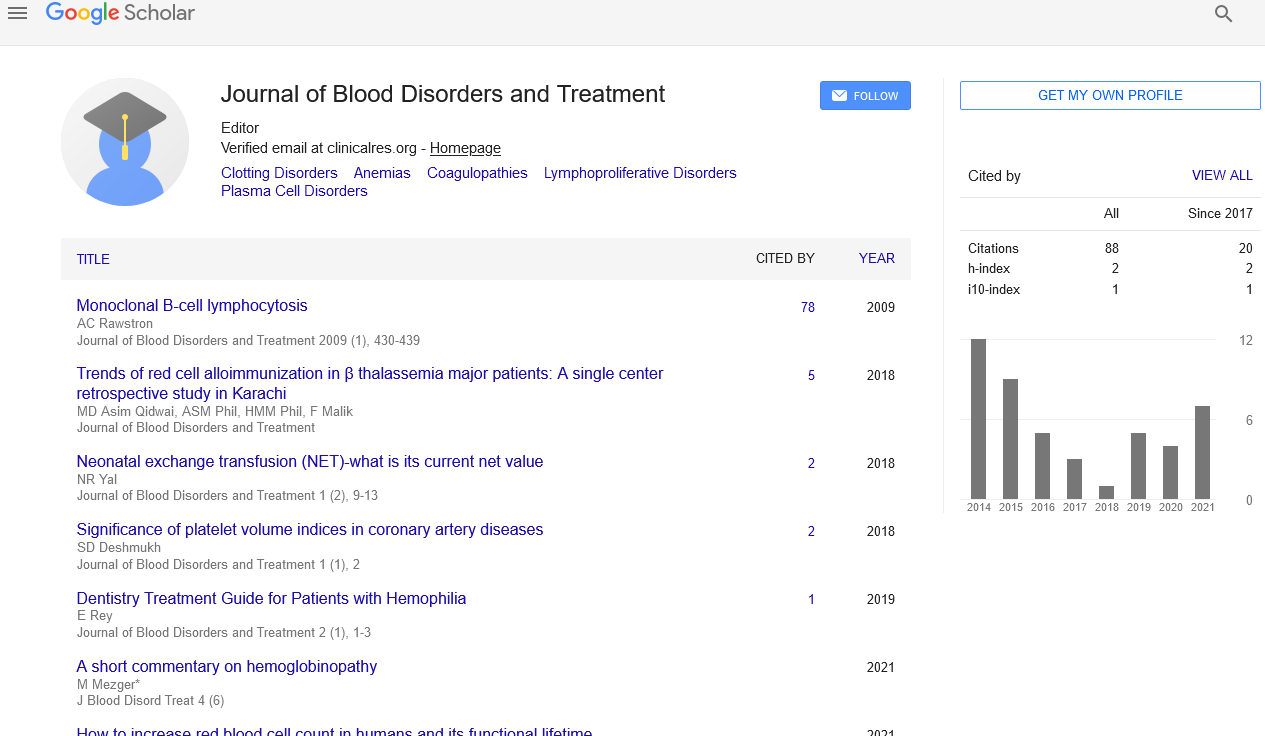Recent Improvements in hemophilia treatment
Received: 05-May-2022, Manuscript No. PULJBDT-22-5100 ; Editor assigned: 07-May-2022, Pre QC No. PULJBDT-22-5100 (PQ); Reviewed: 14-May-2022 QC No. PULJBDT-22-5100 (Q); Revised: 16-May-2022, Manuscript No. PULJBDT-22-5100 (R); Published: 24-May-2022, DOI: 10.37532/puljbdt.2022.5(3)19-20
This open-access article is distributed under the terms of the Creative Commons Attribution Non-Commercial License (CC BY-NC) (http://creativecommons.org/licenses/by-nc/4.0/), which permits reuse, distribution and reproduction of the article, provided that the original work is properly cited and the reuse is restricted to noncommercial purposes. For commercial reuse, contact reprints@pulsus.com
Abstract
In the first 20 years of the third millennium, hemophilia therapy has advanced remarkably, although the innovation started with the 1946 description of plasma fractionation. The earliest attempts at replacement therapy were made in the early 1960s after the finding of FVIII in the cryoprecipitate of frozen plasma and FIX in the supernatant. People with hemophilia (PWH) received concentrates infected by hepatitis A, hepatitis C, and human immunodeficiency virus as these concentrates were manufactured from enormous industrial pools of plasma collected from hundreds of donors, but there were no screening measures for viral infections. The issue of the immunogenicity of exogenously delivered concentrates still has to be fully resolved. The most serious side effect of replacement therapy is the formation of alloantibodies against FVIII in around 25–35 % of PWH. The cloning of the F8 and then F9 genes, which opened the possibility for the production of factor concentrates produced using recombinant DNA technology, was the next significant development.
Key Words
Hemophilia; Alloantibodies; Arthropathy
1.Introduction
Due to a gene mutation in the X chromosome, hemophilia affects men with an XY genotype, but women with a XX genotype are carriers of the condition but may also be impacted and experience bleeding. These women often only experience minor symptoms, but occasionally, when one of the XX chromosomes is non-randomly inactivated (lyonization), they can experience more severe symptoms, particularly menorrhagia.
REPLACEMENT THERAPY
The first treatment for hemophilia, which involved injecting plasma from healthy blood donors, was developed in 1948 when it was determined that the condition was caused by a deficiency of a plasma clotting factor. A globulin fraction of human plasma, isolated using the Cohn's fractionation process and present in the fraction 1-0, was used to successfully treat HA patients in 1958 by Nilsson 1M and Blomback B in Sweden. After the discovery of cryoprecipitate made from the plasma of a single blood donor around the same time in 1964, a new age of hemophilia therapy began. Cryo-precipitation of the plasma was the first stage, but purification techniques, namely immunoaffinity chromatography using monoclonal antibodies specific for FVIll, allowed the production process to obtain a remarkable high specific activity. Even though the danger of infection was lower for cryoprecipitates, the concentrates from large plasma pools and the single donor cryoprecipitates were unfortunately infected by the hepatitis viruses
THE HEMOPHILIA REPLACEMENT THERAPY TARGETS
The primary goals of hemophilia treatment are to manage or stop muscle and joint bleeding as well as life-threatening hemorrhage. Early on, treatment was limited to on-demand therapy, or the infusion of concentrate immediately upon the onset of bleeding, allowing home therapy to be used as a quick and effective treatment. Replacement therapy's goal is to stop both life-threatening bleeding and the consequences that bleeding has on joints and muscles. Some individuals can identify the so-called "aura," or symptoms that foretell bleeding. In contrast, it is better to prevent bleeding than to treat it with on-demand replacement therapy since, in the short term, joint inflammation causes fresh bleeding, which sets off a vicious cycle that results in severe arthropathy. Therefore, it was expected that prophylaxis, also known as prevention of bleeding, would have better results than on-demand medication, particularly if a minimum trough level in the plasma was maintained. To limit bleeding occurrences to one or two per year, it is sufficient to keep the trough level of FVIII or FIX above 3IU/dL–5 IU/dL.
ALTERNATIVE THERAPIES
Despite the advancements in clotting factor accessibility, PWH treatment needs are still not fully satisfied. Surprisingly, the currently available EHL FVIII/FIX solutions minimize the frequency of administration, but treatment must still be given by intravenous infusion with all of the difficulties that entail venous access, especially in young infants. Procoagulant and anticoagulant proteins control the proper coagulation equilibrium in the coagulation system, a complicated mechanism. When alterations influence the balance of the coagulation cascade, the hemostatic status may change, increasing a propensity for bleeding or thrombosis. Several factors that affect the natural hemostatic equilibrium affect the bleeding phenotype of hemophilia patients. dependent on the balance of innate procoagulant and anticoagulant components.
GENE THERAPY
Over the past forty years, significant strides in the treatment of HA and HB have been made, as discussed in the sections above. Efficacy, safety, and patient administration ease deficiencies persist despite these advancements. 100 Despite refined regimens that use PK to customize the treatment regimen and with novel non-factor medicines, breakthrough bleeding still happens when treating HA and HB patients with EHL medications, albeit less frequently. Gene therapy offers the potential to improve quality of life, do away with the necessity for repeated medication administration to stop bleeding,and give hemophiliacs the spontaneity they are deprived of because of the disease's single administration paradigm. People with hemophilia who received a liver transplant for another reason have seen this dramatic effect.
Conclusions
In the first 20 years of the third millennium, hemophilia therapy has advanced significantly, although the innovation began with the description of plasma fractionation in 1946. Hemophiliacs' life expectancy and quality of life have significantly increased over the previous 75 years, and they are now leading lives that are comparable to those of their contemporaries who are not afflicted. Concentrates are now safe thanks to technologies for checking for viral pathogens in blood and blood products and virucidal methods for getting rid of such viruses.





